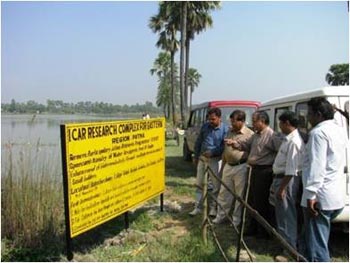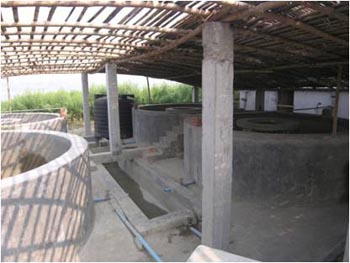 Integrated farming using multiple water use interventions in flood plain wetlands named chaur leads to enhancement in rice and fish production, and other crops like wheat, mustard and tobacco etc. An attempt was made to improve the livelihood of small farm holders (20 households of Kaincha chaur) of Janadha Block in Vaishali district Bihar, during 2008-2010 under the FPARP, funded by Ministry of Water Resources (GOI). During the endeavor, aquaculture formed a substantial part of adoptable technologies which lead to multiple use of abundant water for enhancing productivity to improve upon food security, health and environment which ultimately improved livelihood of the resource poor farmers whose well being, by and large, depends upon this fragile but potential productive ecosystem. Traditionally, the farmer’s cultivate the major crops like rice (av. production 2.0 t/ha), wheat (av. production 2.5 t/ha), and maize (av. production 3.0t/ha), however, extra income generation was very limited. Most of the area of the chaur is cultivated for single crop only during normal rainfall situation but in case of drought years, opportunities do exists in larger areas for raising more than one crop. Keeping these facts in view, five alternative farming activities (i) fish culture in cages (ii) fish culture in low land through pen culture & trenches (iii) rice – fish culture in seasonal waterlogged areas (iv) horticulture - vegetable and livestock production in pond system and (v) raising of fish seed from low cost eco – hatchery, were undertaken for demonstrations of integrated agro-aquaculture systems so as to uplift the socio-economic status of rural poor.
Integrated farming using multiple water use interventions in flood plain wetlands named chaur leads to enhancement in rice and fish production, and other crops like wheat, mustard and tobacco etc. An attempt was made to improve the livelihood of small farm holders (20 households of Kaincha chaur) of Janadha Block in Vaishali district Bihar, during 2008-2010 under the FPARP, funded by Ministry of Water Resources (GOI). During the endeavor, aquaculture formed a substantial part of adoptable technologies which lead to multiple use of abundant water for enhancing productivity to improve upon food security, health and environment which ultimately improved livelihood of the resource poor farmers whose well being, by and large, depends upon this fragile but potential productive ecosystem. Traditionally, the farmer’s cultivate the major crops like rice (av. production 2.0 t/ha), wheat (av. production 2.5 t/ha), and maize (av. production 3.0t/ha), however, extra income generation was very limited. Most of the area of the chaur is cultivated for single crop only during normal rainfall situation but in case of drought years, opportunities do exists in larger areas for raising more than one crop. Keeping these facts in view, five alternative farming activities (i) fish culture in cages (ii) fish culture in low land through pen culture & trenches (iii) rice – fish culture in seasonal waterlogged areas (iv) horticulture - vegetable and livestock production in pond system and (v) raising of fish seed from low cost eco – hatchery, were undertaken for demonstrations of integrated agro-aquaculture systems so as to uplift the socio-economic status of rural poor.
In rice-fish system, rice productivity was recorded to be 4.0 t/ha compared to average yield of 2.0 t/ha in traditional way of cultivation. Similarly, cultivation of bottle gourd on the embankment of pond, yielded 20.0 t/ha additional vegetable crop enhancing income of farmers by Rs.1, 00,000/-ha. Further, traditional yield of fish of 2.0 t/ha from the pond got increased to 3.6 t/ha which resulted additional increase in income of Rs.1, 50,000/-ha. The eggs produced through integration of ducks yielded an additional income of Rs.2, 62,800/-ha. Fish fingerlings raised through cage culture helped farmers in availability of fish seed for stocking of the wetlands. It also gave estimated gross return of Rs.1014/- from one crop per cage of 9 m2. Fish seed production in ten days through eco-hatchery ensured fish seed availability to the farmers. They were benefited with 80 lakhs fish seeds with estimated income of Rs.80000/-. Benefit- cost ratio for cage culture demonstration was worked out to be 2.02 while it was 8.4 in case of polyculture of fish in pond.

Shri Tripurari Chaudhary, an educated (B.Sc.) progressive farmer, who had major land holding (12 acres) in the working site was identified to lead all other farmers and to assist the scientists to undertake all the interventions in participatory mode. This farmer used to get an income of Rs.2, 00,000/- from the various crops and Rs.5o, ooo/- from the fisheries activities per annum. Besides, technological gain related to various IFS modules operation and financial gain with the increase of income by Rs.2, 00, 000/-, per annum, the farmer at the end of the project took the initiative in establishing a commercial fish hatchery as a result of getting acquainted with the technical know-how provided by the scientists of ICAR-RCER, Patna. He was also helped in his endeavor by organizations like CIFA, Bhubaneswar; Department of Fisheries, Bihar and the financial institution such as Oriental Bank of Commerce, Hazipur, Vaishali. He finally established a commercial hatchery for fish seed production with a capacity of 40 lacks spawn per day at Jandha, Vaishali, in Bihar. Many farmers are coming forward to adopt techniques of multiple uses of water for their farming approach
(Source: ICAR Research Complex for Eastern Region ,Patna)







फेसबुक पर लाइक करें
यूट्यूब पर सदस्यता लें
X पर फॉलो करना X
इंस्टाग्राम पर लाइक करें